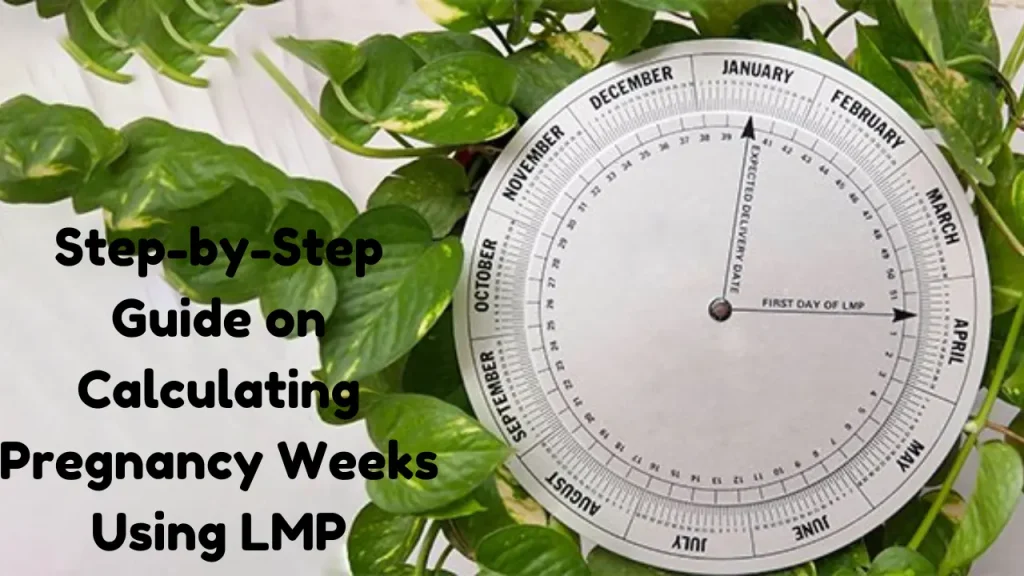Those women who are conceiving the pregnancy always worry about their pregnancy week calculations, to know about how that entire thing works, how she needs to maintain her health and her diet, and everything around that. Knowing all about that, the details of pregnancy weeks become crucial information for an expecting mother. But do you know, having all the details about pregnancy weeks is not that easy to think about?
This is why, in this blog, we have added all the details about How To Calculate Pregnancy Weeks. If you are also looking to know about How To Calculate Pregnancy Weeks and how you can get all the important details about pregnancy weeks, then this blog will help you in and out. We have provided you with a comprehensive guide about pregnancy weeks and also How To Calculate Pregnancy Weeks.
So, letŌĆÖs start:-
Understanding of Pregnancy Weeks

We have added simplified details about the pregnancy weeks below that will help you gain an overall understanding of what is pregnancy weeks and what is its importance:
What Are Pregnancy Weeks?
Definition and explanation of pregnancy weeks: Pregnancy weeks are a way to track the progress of a pregnancy, calculated from the first day of your last menstrual period (LMP). This method of pregnancy week calculations helps to estimate due dates and monitor fetal development. To calculate pregnancy weeks, count the number of weeks since your LMP.
This standard method divides pregnancy into three trimesters, each with distinct milestones. Knowing how to calculate pregnancy weeks is crucial for understanding the stages of pregnancy and scheduling medical check-ups. Accurate calculations ensure you and your healthcare provider can monitor your pregnancy’s health effectively.
Read More: Free Ambulance Service for Pregnant Women in India
Importance of Tracking Pregnancy Weeks
These are the major point that explains the importance of tracking pregnancy weeks simply:
- Monitor Fetal Development: Tracking Pregnancy Weeks allows you to follow your baby’s growth and development each week.
- Identify Milestones: Tracking Pregnancy Weeks Helps you recognize and celebrate important milestones in your pregnancy.
- Schedule Prenatal Visits: Tracking Pregnancy Weeks Ensures timely prenatal check-ups and necessary tests.
- Manage Symptoms: Tracking Pregnancy Weeks Helps you understand and manage pregnancy symptoms specific to each week.
- Prepare for Trimesters: Tracking Pregnancy Weeks provides a clear understanding of trimester transitions and associated changes.
- Plan for Delivery: Knowing about Pregnancy Weeks Aids in planning for your baby’s due date and preparing for labor.
- Ensure Proper Nutrition: Knowing about Pregnancy Weeks will guide you in maintaining a healthy diet tailored to each stage of pregnancy.
- Track Health Changes: Tracking Pregnancy Weeks Helps in monitoring your health and identifying any potential issues early.
- Emotional Preparedness: Tracking Pregnancy Weeks keeps you emotionally prepared by knowing what to expect each week.
- Educate Yourself: Tracking Pregnancy Weeks increases your knowledge about pregnancy stages and fetal development.
How are Pregnancy Weeks Calculated?
Calculating how many weeks pregnant you are is essential for tracking the progress of your pregnancy, planning prenatal visits, and preparing for your baby’s arrival. There are two primary methods for calculating pregnancy weeks: the Last Menstrual Period (LMP) method and the conception date method.
Overview of the Last Menstrual Period (LMP) Method
The LMP method is the most commonly used way to calculate pregnancy weeks. It is based on the first day of your last menstrual period before you become pregnant.
Steps to Calculate Using the LMP Method
- Identify the First Day of Your Last Period: Note the first day of your last menstrual cycle.
- Count the Weeks: Begin counting from this day to the current date to determine how many weeks pregnant you are.
Example
If the first day of your last period was January 1st and today’s date is March 1st, you are approximately 8 weeks pregnant. This method assumes a regular 28-day menstrual cycle and considers the two weeks before ovulation as part of the pregnancy duration.
Benefits of the LMP Method:
- Widely used and recognized by healthcare providers.
- Easy to determine without needing additional information.
Limitations of the LMP Method:
- Less accurate for women with irregular menstrual cycles.
- Doesn’t account for the exact date of conception, which can vary.
The Conception Date Method
The conception date method calculates pregnancy weeks starting from the day of conception, which typically occurs about two weeks after the start of the last menstrual period.
Steps to Calculate Using Conception Date Method:
- Identify the Conception Date: Note the date you believe you conceived.
- Add Two Weeks: Add approximately two weeks to this date to align with the traditional counting method.
Example
If you know you conceived on January 15th, add two weeks, making it January 29th. Count the weeks from January 29th to todayŌĆÖs date to find out how many weeks pregnant you are.
Benefits of Conception Date Method
- More accurate for women who know their conception date.
- Useful for pregnancies achieved through assisted reproductive technologies (ART) like IVF.
Limitations of Conception Date Method
Hard to determine the exact conception date without medical assistance or detailed tracking.
Differences Between LMP and Conception Date Methods
- Starting Point: The LMP method starts from the first day of your last period, while the conception date method starts from the date of conception plus two weeks.
- Accuracy: LMP is less accurate for women with irregular cycles or those unsure of their LMP date. The conception date method is more precise if the conception date is known.
- Medical Use: Healthcare providers commonly use the LMP method for its simplicity and ease of use, but may adjust the due date based on ultrasound measurements and conception date when available.
Details about Pregnancy Calculators
Pregnancy calculators are valuable tools for expecting parents to estimate the due date, track the progress of the pregnancy, and plan for upcoming milestones. These calculators can provide information in weeks and days, helping you understand which stage of pregnancy you are in and what to expect.
Pregnancy Calculator in Weeks and Days
A pregnancy calculator in weeks and days offers a detailed breakdown of your pregnancy progress. This level of detail is helpful for understanding specific developments and symptoms that occur at different points in the pregnancy.
Key Features
Weeks and Days Breakdown: Provides the exact number of weeks and days you have been pregnant.
Due Date Estimation: Predict the estimated due date based on the provided information.
Milestone Tracking: Highlights key milestones and developmental stages of the baby.
Trimester Information: Indicates which trimester you are currently in.
Benefits
- Helps with precise tracking of pregnancy progress.
- Offers detailed insights into the baby’s development.
- Useful for scheduling prenatal appointments and planning.
How to Use an Online Pregnancy Calculator
Using an online pregnancy calculator is straightforward. HereŌĆÖs a step-by-step guide to help you navigate the process:
- Find a Reliable Pregnancy Calculator:
- Search for reputable pregnancy calculators on trusted health websites or use apps designed for pregnancy tracking.
- Input Required Information:
- Last Menstrual Period (LMP): Enter the first day of your last menstrual period.
- Conception Date (Optional): If you know the exact conception date, you can enter it instead.
- Cycle Length (Optional): Some calculators ask for your average menstrual cycle length for more accuracy.
- Calculate:
- Click on the calculate button or similar prompt. The calculator will process the information and provide results.
- Review the Results:
- Weeks and Days Pregnant: The calculator will show how many weeks and days you are pregnant.
- Estimated Due Date: It will predict your due date based on the provided information.
- Current Trimester: It will indicate which trimester you are in.
- Key Milestones: Some calculators provide additional details about the baby’s development at your current stage.
Example of Using an Online Pregnancy Calculator:
- Visit a trusted pregnancy website.
- Enter the first day of your last menstrual period (e.g., January 1st).
- Enter your average cycle length if asked (e.g., 28 days).
- Click the calculate button.
- Review the results: You are 10 weeks and 3 days pregnant, with an estimated due date of October 8th.
Benefits of Using an Online Pregnancy Calculator:
- Convenience: Accessible from anywhere with an internet connection.
- Accuracy: Provides a reliable estimate based on standard medical calculations.
- Detailed Information: Offers insights into both maternal and fetal development.
- Ease of Use: User-friendly interfaces make it simple to input information and understand results.
Pregnancy Calculator by LMP
The Last Menstrual Period (LMP) method is a common and straightforward way to calculate how many weeks pregnant you are. This method uses the first day of your last menstrual period to estimate the start of your pregnancy, which is typically two weeks before ovulation and conception.
Step-by-Step Guide on Calculating Pregnancy Weeks Using LMP

1. Identify the First Day of Your Last Menstrual Period (LMP):
This is the first day you started bleeding during your last period.
2. Count the Weeks:
Starting from the first day of your LMP, count forward in weeks to the current date.
3. Adjust for Cycle Length (Optional):
If your menstrual cycle is not the typical 28 days, adjust the calculation accordingly. For shorter or longer cycles, this may affect the estimated conception date and due date.
4. Estimate Your Due Date:
Add 280 days (or 40 weeks) to the first day of your LMP. This is the average length of a pregnancy.
Also Read: Introduction to how to relieve back pain during Pregnancy
Calculations
Regular 28-Day Cycle
- Identify the First Day of LMP:
- Let’s say your last period started on January 1st.
- Count the Weeks:
- If today is March 15th, count the number of weeks from January 1st to March 15th.
- January 1st to January 8th: 1 pregnancy week
- January 8th to January 15th: 2 pregnancy weeks
- January 15th to January 22nd: 3 pregnancy weeks
- January 22nd to January 29th: 4 pregnancy weeks
- January 29th to February 5th: 5 pregnancy weeks
- February 5th to February 12th: 6 pregnancy weeks
- February 12th to February 19th: 7 pregnancy weeks
- February 19th to February 26th: 8 pregnancy weeks
- February 26th to March 4th: 9 pregnancy weeks
- March 4th to March 11th: 10 pregnancy weeks
- March 11th to March 15th: 10 pregnancy weeks and 4 days
- Result:
- You are 10 weeks and 4 days pregnant.
Irregular 35-Day Cycle
- Identify the First Day of LMP:
- Let’s say your last period started on January 1st.
- Adjust for Cycle Length:
- If your average cycle length is 35 days, ovulation likely occurred later than the standard 14 days after LMP. Adjust the ovulation date to around 21 days after the LMP.
- Count the Weeks:
- Starting from January 1st, count the weeks to today’s date, considering the adjusted cycle length.
- Estimate Your Due Date:
- Add 280 days to January 1st, which is around October 8th. Adjust this estimate based on the later ovulation date.
Benefits of Using the LMP Method
- Simplicity: Easy to use and understand without the need for medical intervention.
- Accessibility: Does not require knowledge of the exact conception date.
- Widely Accepted: Commonly used by healthcare providers for initial pregnancy assessments.
Limitations of the LMP Method
- Irregular Cycles: Less accurate for women with irregular menstrual cycles.
- Uncertain LMP Date: If you do not remember the exact date of your last period, calculations may be off.
- Variability in Ovulation: Not all women ovulate exactly 14 days after the start of their period, leading to potential inaccuracies.
Pregnancy Weeks and Trimesters
Pregnancy is divided into three main phases known as trimesters. Each trimester marks different stages of fetal development and maternal changes. Understanding these trimesters helps in tracking pregnancy progress and ensuring both the motherŌĆÖs and babyŌĆÖs health.
Understanding the Pregnancy Trimester
Definition: A trimester is one of the three divisions of pregnancy, each lasting about three months. The trimesters represent different developmental stages for the fetus and specific changes for the mother.
Duration of Each Trimester:
- First Trimester: Weeks 1 to 12
- Second Trimester: Weeks 13 to 26
- Third Trimester: Weeks 27 to 40 (or until birth)
Importance of Trimesters in Pregnancy Tracking:
- Monitoring Fetal Development: Different milestones and development stages occur in each trimester.
- Planning Medical Care: Prenatal visits and specific tests are often scheduled according to the trimester.
- Managing Symptoms: Knowing which trimester you are in helps anticipate and manage common pregnancy symptoms.
- Emotional and Physical Preparation: Understanding trimesters aids in preparing for the physical and emotional changes during pregnancy.
Calculating Trimester of Pregnancy
To calculate which trimester you are in, you need to know the number of weeks you have been pregnant. This is typically counted from the first day of your last menstrual period (LMP).
Detailed Calculation:
- First Trimester: From the first day of your LMP to the end of week 12.
- Second Trimester: From the beginning of week 13 to the end of week 26.
- Third Trimester: From the beginning of week 27 to the end of week 40 or until delivery.
Calculation:
Determine Weeks Pregnant:
If your LMP was January 1st and today is April 1st, you are approximately 13 weeks pregnant.
- Identify the Trimester: Since 13 weeks falls into the range of the second trimester, you are in the second trimester.
Week-by-Week Breakdown of Each Trimester
- First Trimester (Weeks 1-12):
- Weeks 1-4: Fertilization, implantation, and the start of embryonic development.
- Weeks 5-8: Major organs and body systems begin to form. Heartbeat can be detected.
- Weeks 9-12: Embryo transitions to a fetus. Facial features develop, and limbs become more defined.
- Second Trimester (Weeks 13-26):
- Weeks 13-16: Rapid growth of the fetus. Hair, eyebrows, and eyelashes begin to form.
- Weeks 17-20: The fetus starts to move, and movements can be felt by the mother (quickening).
- Weeks 21-24: Fetal development continues, including the development of senses. The fetus can hear and respond to sounds.
- Weeks 25-26: Lungs and other organs mature. The fetus gains more weight and starts to develop a sleep-wake cycle.
- Third Trimester (Weeks 27-40):
- Weeks 27-30: Rapid brain development. The fetus opens its eyes and practices breathing movements.
- Weeks 31-34: The fetus continues to gain weight. Bones harden, but the skull remains soft and flexible for birth.
- Weeks 35-37: The fetus is considered early term. Movements may decrease due to limited space.
- Weeks 38-40: Full-term pregnancy. The fetus’s lungs and other vital organs are fully developed. The baby positions itself for birth.
Also Read: Top 10 Ambulance Service in Kolkata
Tracking pregnancy symptoms by week
Tracking pregnancy symptoms by week helps expecting parents understand what to expect and how to manage various changes. Early symptoms can vary widely, but understanding common signs can provide reassurance and guidance.
Pregnancy Week 1 Symptoms
Common Symptoms in the First Week of Pregnancy:
In the first week of pregnancy, you may not experience noticeable symptoms since conception typically occurs around two weeks after the start of your last menstrual period (LMP). However, some early signs might appear:
1. Mild Cramping and Spotting:
Known as implantation bleeding, light spotting may occur when the fertilized egg attaches to the uterine lining.
2. Breast Tenderness:
Hormonal changes can cause your breasts to feel sore, heavy, or sensitive to touch.
3. Fatigue:
Increased progesterone levels can make you feel unusually tired.
4. Mood Swings:
Hormonal fluctuations can lead to moodiness or emotional changes.
5. Bloating:
Hormonal shifts may cause bloating similar to premenstrual symptoms.
What to Expect During Early Pregnancy?
1. Hormonal Changes:
Hormones like progesterone and human chorionic gonadotropin (hCG) rise rapidly, preparing your body for pregnancy.
2. No Confirmed Pregnancy:
It’s too early for a home pregnancy test to detect hCG levels accurately. Confirmation usually occurs around week 4 or after a missed period.
3. Lifestyle Adjustments:
Start taking prenatal vitamins and avoid harmful substances like alcohol and tobacco. Maintaining a healthy diet and exercise routine is also beneficial.
Pregnancy Week 6 Symptoms
By week 6, you may start experiencing more pronounced pregnancy symptoms due to the significant hormonal changes occurring in your body.
Typical Symptoms at Six Weeks Pregnant:
- Nausea and Vomiting: Commonly known as morning sickness, these symptoms can occur at any time of the day.
- Breast Changes: Breasts may become even more tender, and the areolas might darken.
- Frequent Urination: The growing uterus puts pressure on your bladder, increasing the need to urinate.
- Fatigue: Continued high levels of progesterone can cause persistent tiredness.
- Mood Swings: Emotional fluctuations are common due to hormonal changes.
- Bloating and Gas: Increased progesterone slows digestion, leading to bloating and gas.
- Food Cravings or Aversions: You might experience strong cravings for certain foods or aversions to others.
- Increased Sense of Smell: Heightened sensitivity to smells can trigger nausea or aversions.
- Mild Cramping and Spotting: Light cramping and spotting can still occur but should be monitored for any changes.
Read More: Challenges Faced by Ambulance Services: Overcoming Obstacles in Emergency Medical Care
What to Expect in 6 weeks of Pregnancy?
- Embryonic Development: The embryo is about the size of a lentil and develops major organs, including the heart, which may start to beat.
- Hormonal Levels: hCG levels are high enough to confirm pregnancy with a home test. Your healthcare provider can also confirm it through a blood test.
- Physical Changes: You might notice slight weight gain or changes in your abdomen, though these are usually minimal at this stage.
- Prenatal Care: Schedule your first prenatal visit if you haven’t already. Your healthcare provider will likely perform an ultrasound to check the baby’s development and discuss your health and pregnancy plan.
Pregnancy Weeks to Months Conversion
Converting pregnancy weeks to months can sometimes be confusing due to the varying lengths of months. A typical pregnancy lasts around 40 weeks, but this is often referred to in months for simplicity and ease of understanding.
Weeks to Months Chart
Here is a simple conversion chart to help you understand how pregnancy weeks translate into months:
| Weeks Pregnant | Months Pregnant |
| 1 – 4 | 1 month |
| 5 – 8 | 2 months |
| 9 – 13 | 3 months (1st Trimester) |
| 14 – 17 | 4 months |
| 18 – 21 | 5 months |
| 22 – 26 | 6 months (2nd Trimester) |
| 27 – 30 | 7 months |
| 31 – 35 | 8 months |
| 36 – 40 | 9 months (3rd Trimester) |
Step-by-Step Guide to Convert Weeks to Months

To convert pregnancy weeks to months, you can follow these steps:
- Understand the Basics: A typical month is about 4.3 weeks (30.4 days on average).
- Use Simple Division: Divide the number of weeks by 4.3 to get the approximate number of months.
- Match with Common Pregnancy Milestones: Use common pregnancy milestones (trimesters) to cross-check and ensure accuracy.
Calculation
- Find the Number of Weeks:
- LetŌĆÖs say you are 20 weeks pregnant.
- Divide by 4.3
- 20 ├Ę 4.3 Ōēł 4.65
- Interpret the Result:
- You are approximately 4.65 months pregnant, which is around 4 months and 3 weeks.
Conversions
12 Weeks Pregnant
- Calculate:
- 12├Ę4.3Ōēł2.79
- Interpret:
- You are approximately 2.8 months pregnant, which means you are nearing the end of your 3rd month.
25 Weeks Pregnant
- Calculate:
- 25├Ę4.3Ōēł5.81
- Interpret:
- You are approximately 5.8 months pregnant, nearing the end of your 6th month.
34 Weeks Pregnant
- Calculate:
- 34├Ę4.3Ōēł7.91
- Interpret:
- You are approximately 7.9 months pregnant, close to completing your 8th month.
Know More: Best Diet for Diabetes Control
Practical Application
While this chart and method provide a general guideline, remember that the exact conversion can vary slightly depending on the specific lengths of months and your menstrual cycle. HereŌĆÖs a practical application of the conversion:
1. Check Your Weeks:
Use a pregnancy app or calculator to determine your exact weeks pregnant.
2. Use the Conversion Chart:
Refer to the chart to quickly find the corresponding month.
3. Adjust for Specific Months:
For more precision, especially when tracking detailed milestones or planning for delivery, consider consulting with your healthcare provider.
Total Weeks in Pregnancy
Understanding the total duration of pregnancy in weeks is essential for expecting parents and healthcare providers alike. Here’s a comprehensive overview of the standard duration of pregnancy, its significance, and why the 40-week benchmark is important.
Explanation of the Standard Duration of Pregnancy in Weeks
- Typical Duration: Pregnancy is commonly counted as lasting for 40 weeks, starting from the first day of the woman’s last menstrual period (LMP) to the estimated due date. This period is divided into three trimesters, each approximately 13 weeks long.
- Calculation Basis: The 40-week timeframe is based on the average length of time it takes for a baby to develop and mature before birth. It accounts for the variability in gestational development among different pregnancies.
- Developmental Milestones: During these 40 weeks, the fetus undergoes significant growth and development. Major organs form in the first trimester, followed by rapid growth and refinement of bodily functions in the second and third trimesters.
Importance of the 40-Week Benchmark
1. Developmental Adequacy:
The 40-week duration allows sufficient time for the fetus to develop essential organs and systems fully. Premature births before 37 weeks (preterm birth) can lead to health complications due to incomplete development.
2. Medical Standardization:
Healthcare providers use the 40-week benchmark as a standard for tracking fetal growth, assessing pregnancy progress, and scheduling prenatal care and testing.
3. Predictability and Planning:
Knowing the expected duration helps parents and healthcare providers plan for childbirth, anticipate labor signs, and ensure readiness for the delivery.
4. Healthy Outcomes:
Babies born closer to 40 weeks tend to have better birth weights and fewer complications compared to those born prematurely or post-term (after 42 weeks).
5. Legal and Social Norms:
In many countries, maternity leave policies and legal definitions of pregnancy duration are based on the 40-week standard.
Read More: Complete Details About First Aid | Types, Benefits & Tips
Total Weeks Breakdown
- First Trimester: Weeks 1 to 12
- Second Trimester: Weeks 13 to 26
- Third Trimester: Weeks 27 to 40 (or until birth)
- Weeks 1-4: Early embryonic development and implantation.
- Weeks 5-8: Organogenesis (development of major organs).
- Weeks 9-12: Fetal development continues; external features begin to form.
- Weeks 13-26: Rapid growth; fetal movements felt by the mother.
- Weeks 27-40: Final maturation of organs and systems; preparation for birth.
Week-by-Week Pregnancy Guide
A week-by-week pregnancy guide provides a detailed overview of fetal development and maternal changes throughout each stage of pregnancy. Here’s a comprehensive explanation covering the pregnancy weeks chart, key milestones, and developments for each week:
Pregnancy Weeks Chart
A pregnancy weeks chart outlines the progression of pregnancy from conception to birth, typically spanning 40 weeks. It serves as a reference for tracking fetal growth, maternal symptoms, and healthcare milestones.
Comprehensive Chart of Pregnancy Week-by-Week

Weeks 1-4:
- Fetal Development:
- Fertilization and implantation occur during these weeks.
- The blastocyst (early embryo) forms and implants in the uterine lining.
- Development of the placenta begins.
- Maternal Changes:
- Often unaware of pregnancy; may experience mild symptoms like fatigue or spotting.
Weeks 5-8:
- Fetal Development:
- Major organs and systems begin to form (heart, brain, spinal cord).
- Limb buds appear, and facial features start to develop.
- Heartbeat may be detectable by the end of week 6.
- Maternal Changes:
- Morning sickness (nausea and vomiting) may begin.
- Breast tenderness and fatigue increase due to hormonal changes.
Weeks 9-12:
- Fetal Development:
- The fetus transitions from an embryo; major organs continue to develop.
- External features become more defined (fingers, toes, facial features).
- Sex organs begin to differentiate.
- Maternal Changes:
- Symptoms may stabilize or decrease (morning sickness may lessen).
- Visible changes in the abdomen and breasts; the uterus expands.
Weeks 13-16:
- Fetal Development:
- Rapid growth; the fetus is more active and can make reflexive movements.
- The skeletal system starts to form bones.
- Hair, eyebrows, and eyelashes begin to grow.
- Maternal Changes:
- Energy levels improve; may feel more comfortable.
- Increased appetite; weight gain becomes noticeable.
Weeks 17-20:
- Fetal Development:
- Fetal movements (quickening) become more pronounced and may be felt by the mother.
- Vernix (protective coating) develops on the skin.
- The sex of the baby can often be determined via ultrasound.
- Maternal Changes:
- The belly starts to grow visibly.
- Skin changes (darkening of the nipples and linea nigra).
Weeks 21-24:
- Fetal Development:
- The fetus continues to gain weight and size.
- Lung development progresses; surfactant production begins.
- The ability to hear and respond to external sounds develops.
- Maternal Changes:
- Braxton Hicks contractions may begin (practice contractions).
- Increased backache and discomfort due to weight gain.
Weeks 25-28:
- Fetal Development:
- Eyes open and close; baby responds to light.
- The brain continues to develop; sleep-wake cycles become more defined.
- Rapid weight gain continues; lungs mature further.
- Maternal Changes:
- Shortness of breath due to the uterus pressing against the diaphragm.
- Increased pelvic pressure; difficulty sleeping comfortably.
Weeks 29-32:
- Fetal Development:
- The fetus has distinct sleep patterns; kicks and stretches are frequent.
- Development of fat layers under the skin; smoother appearance.
- Eyes can open and close; bones fully developed but still soft.
- Maternal Changes:
- Increased frequency of Braxton Hicks contractions.
- Swelling in ankles and feet (edema) due to fluid retention.
Weeks 33-36:
- Fetal Development:
- Continued growth and weight gain; less room for fetal movement.
- Fetus settles into a head-down position in preparation for birth.
- Immune system development; antibody transfer from mother.
- Maternal Changes:
- Increased backache and discomfort; difficulty finding a comfortable position.
- Preparation for labor begins; nesting instincts may appear.
Weeks 37-40:
- Fetal Development:
- The fetus is considered full-term by week 37.
- Continued growth; the baby may engage in the pelvis (drop).
- Lung maturation and readiness for breathing outside the womb.
- Maternal Changes:
- Braxton Hicks contractions intensify; signs of labor may begin (mucus plug, bloody show).
- Increased fatigue and restlessness; anticipation of childbirth.
Book Ambulance: GoAid Ambulance Service
Conclusion to how to calculate pregnancy weeks
In conclusion, understanding how to calculate pregnancy weeks is crucial for monitoring fetal development and maternal health. By tracking from the last menstrual period (LMP) or conception date, expecting parents can estimate due dates and plan prenatal care. Pregnancy weeks also help healthcare providers assess growth milestones and detect any deviations for timely intervention.
Knowing which trimester and week of pregnancy you are in allows for better preparation and understanding of the changes ahead. Ultimately, accurate calculation ensures comprehensive care and supports a healthy pregnancy journey from conception to childbirth.
Also, if you have any query related to how to calculate pregnancy weeks, then write that query in the comment box. We will surely reply to that query as soon as possible.
FAQs related to how to calculate pregnancy weeks
Pregnancy weeks are calculated by counting from the first day of your last menstrual period (LMP). This method assumes conception occurs around two weeks after LMP, so subtract two weeks from the current date to estimate how many weeks pregnant you are.
Yes, you can calculate pregnancy weeks from the conception date if you know it. Count weeks from the conception date to determine how far along you are. This method is more precise if you are sure about the date of conception.
Pregnancy calculators are generally accurate for estimating weeks of pregnancy based on either LMP or conception date. They use standard formulas to calculate gestational age, but individual variations can affect exact accuracy.
Irregular menstrual cycles can make it challenging to pinpoint exact conception and due dates. In such cases, ultrasound scans are often used to confirm gestational age and adjust for irregularities in cycle length.
No, pregnancy weeks are calculated similarly regardless of cycle length. It’s counted from the first day of your last period, regardless of whether your cycles are longer or shorter than the average 28 days.
Accurate calculation of pregnancy weeks helps in monitoring fetal development, scheduling prenatal care, and preparing for childbirth. It ensures that healthcare providers can track milestones and intervene if there are any concerns about growth or development.
Yes, calculating pregnancy weeks helps estimate the due date, which is typically 40 weeks from the first day of the last menstrual period. This estimation guides healthcare planning and preparation for delivery.
Weeks pregnant” and “weeks of gestation” generally refer to the same conceptŌĆöhow far along you are in pregnancy. Both terms indicate the number of weeks since conception or LMP.
Healthcare providers use pregnancy week calculations to track fetal growth, assess developmental milestones, and plan necessary tests or interventions. It guides discussions about health, nutrition, and preparation for childbirth.
Yes, if the due date changes based on ultrasound or other assessments, healthcare providers adjust the pregnancy weeks calculation accordingly. This ensures ongoing accuracy in monitoring the progression of pregnancy.
















